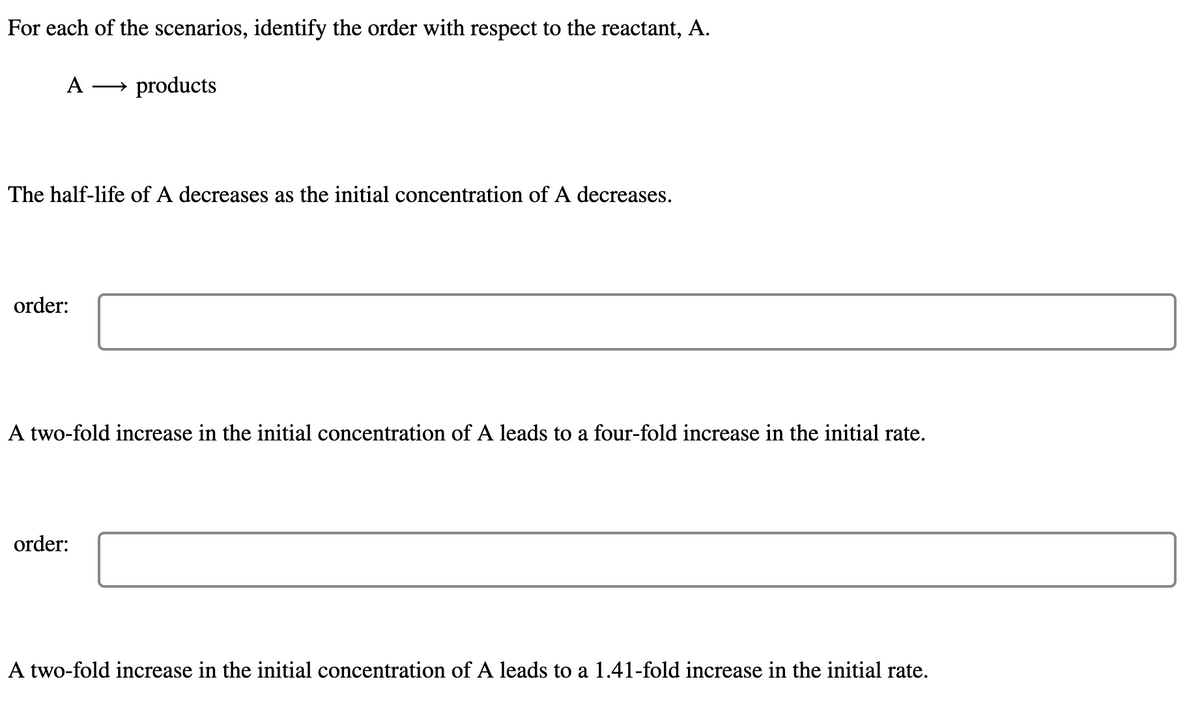For each of the scenarios, identify the order with respect to the reactant, A. A → products The half-life of A decreases as the initial concentration of A decreases. order: A two-fold increase in the initial concentration of A leads to a four-fold increase in the initial rate. order: A two-fold increase in the initial concentration of A leads to a 1.41-fold increase in the initial rate.
For each of the scenarios, identify the order with respect to the reactant, A. A → products The half-life of A decreases as the initial concentration of A decreases. order: A two-fold increase in the initial concentration of A leads to a four-fold increase in the initial rate. order: A two-fold increase in the initial concentration of A leads to a 1.41-fold increase in the initial rate.
Chemistry: The Molecular Science
5th Edition
ISBN:9781285199047
Author:John W. Moore, Conrad L. Stanitski
Publisher:John W. Moore, Conrad L. Stanitski
Chapter11: Chemical Kinetics: Rates Of Reactions
Section: Chapter Questions
Problem 39QRT
Related questions
Question

Transcribed Image Text:For each of the scenarios, identify the order with respect to the reactant, A.
A
products
The half-life of A decreases as the initial concentration of A decreases.
order:
A two-fold increase in the initial concentration of A leads to a four-fold increase in the initial rate.
order:
A two-fold increase in the initial concentration of A leads to a 1.41-fold increase in the initial rate.
![A two-fold increase in the initial concentration of A leads to a 1.41-fold increase in the initial rate.
order:
The time required for [A] to decrease from [A], to [A],/2 is equal to the time required for [A] to decrease from [A],/2 to
[A],/4.
order:
The rate of decrease of [A] is a constant.
order:](/v2/_next/image?url=https%3A%2F%2Fcontent.bartleby.com%2Fqna-images%2Fquestion%2Ff00f8b75-2bac-4335-a200-62a4fa07a89d%2F1a7dc3c4-1e29-40d8-95f7-b92db9855588%2F9deipj_processed.png&w=3840&q=75)
Transcribed Image Text:A two-fold increase in the initial concentration of A leads to a 1.41-fold increase in the initial rate.
order:
The time required for [A] to decrease from [A], to [A],/2 is equal to the time required for [A] to decrease from [A],/2 to
[A],/4.
order:
The rate of decrease of [A] is a constant.
order:
Expert Solution
This question has been solved!
Explore an expertly crafted, step-by-step solution for a thorough understanding of key concepts.
This is a popular solution!
Trending now
This is a popular solution!
Step by step
Solved in 3 steps with 3 images

Knowledge Booster
Learn more about
Need a deep-dive on the concept behind this application? Look no further. Learn more about this topic, chemistry and related others by exploring similar questions and additional content below.Recommended textbooks for you

Chemistry: The Molecular Science
Chemistry
ISBN:
9781285199047
Author:
John W. Moore, Conrad L. Stanitski
Publisher:
Cengage Learning

Chemistry: Principles and Reactions
Chemistry
ISBN:
9781305079373
Author:
William L. Masterton, Cecile N. Hurley
Publisher:
Cengage Learning

Chemistry: Principles and Practice
Chemistry
ISBN:
9780534420123
Author:
Daniel L. Reger, Scott R. Goode, David W. Ball, Edward Mercer
Publisher:
Cengage Learning

Chemistry: The Molecular Science
Chemistry
ISBN:
9781285199047
Author:
John W. Moore, Conrad L. Stanitski
Publisher:
Cengage Learning

Chemistry: Principles and Reactions
Chemistry
ISBN:
9781305079373
Author:
William L. Masterton, Cecile N. Hurley
Publisher:
Cengage Learning

Chemistry: Principles and Practice
Chemistry
ISBN:
9780534420123
Author:
Daniel L. Reger, Scott R. Goode, David W. Ball, Edward Mercer
Publisher:
Cengage Learning

General Chemistry - Standalone book (MindTap Cour…
Chemistry
ISBN:
9781305580343
Author:
Steven D. Gammon, Ebbing, Darrell Ebbing, Steven D., Darrell; Gammon, Darrell Ebbing; Steven D. Gammon, Darrell D.; Gammon, Ebbing; Steven D. Gammon; Darrell
Publisher:
Cengage Learning

Chemistry for Engineering Students
Chemistry
ISBN:
9781285199023
Author:
Lawrence S. Brown, Tom Holme
Publisher:
Cengage Learning

Chemistry by OpenStax (2015-05-04)
Chemistry
ISBN:
9781938168390
Author:
Klaus Theopold, Richard H Langley, Paul Flowers, William R. Robinson, Mark Blaser
Publisher:
OpenStax